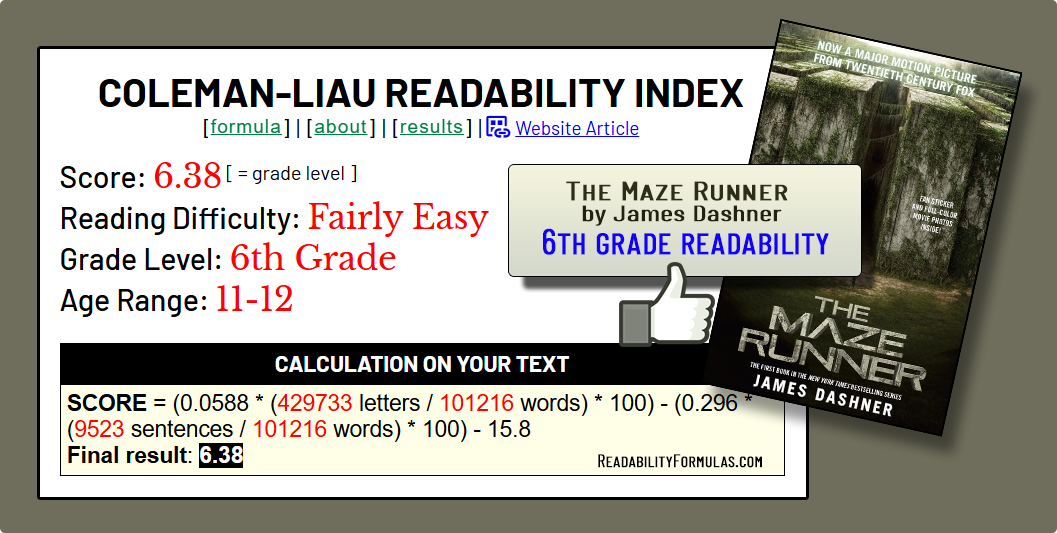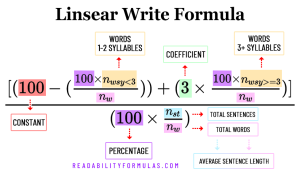The Coleman–Liau Index is a readability formula to score text difficulty. Linguists Meri Coleman and T. L. Liau created the formula to help the U.S. Office of Education adapt the readability of textbooks for the public school system.
Similar to the Automated Readability Index, but unlike other grade-level predictors, the Coleman–Liau relies on characters (alphabetical letters). Instead of using syllable/word and sentence length indices, Coleman and Liau believed computerized grading understand characters more easily and accurately than counting syllables and sentence length. (Letters, as defined by Coleman-Liau, can include alphabetical letters as well as numbers (digits). White space and other characters are not counted.)
The formula is as follows:
The Coleman-Liau Readability Formula
$$5.88 \times AWL + 29.6 \times \frac{Sentences}{Words} – 15.8$$
What Are the Numbers in Coleman–Liau Index?
Coleman–Liau assigned the constants (0.0588 and 0.296) through data-based mapping—examining many texts and their readability levels. The constant of 15.8 at the end adjusts the score to align the result with U.S. grade levels. A score of 8.5 means a student in 8-9th grade can understand the text with little challenge.
15.8 (Constant)
What is it?
- This is a fixed number that does not change regardless of the text. It adjusts the final score to align with U.S. grade levels. Without the constant, the formula would produce results that mismatch real-world readability levels.
0.0588 (Coefficient of Letters)
What is it?
- This scales the effect of the letter count on readability. It means longer words (more letters per word) increase text difficulty.
-0.296 (Coefficient of Sentences)
What is it?
- This scales the effect of the sentence count on readability. The negative sign means that more sentences per 100 words make the text easier to read.
Unlike syllable-based readability indicators, The Coleman–Liau Index does not require you to analyze the characters that create the words (such as syllable counts)—only their length in characters. According to Coleman, “There is no need to estimate syllables since word length in letters is a better predictor of readability than word length in syllables.”
Limitations of the Coleman-Liau Index
While the calculation is simple and easy to use, it’s limited in these areas:
- Language Sensitivity: The formula assumes certain characteristics of English, such as word and sentence lengths. It’s difficult to apply it to non-English languages.
- Ignores Vocabulary Complexity: The Coleman-Liau Index doesn’t consider how complex or simple words are in a text; it focuses only on letter count.
- Sentence Complexity: The index doesn’t consider complex sentences. A text with simple sentences but with complex concepts may yield a misleading score.
Despite these limitations, the formula is used in these areas:
Education: The Common Education Data Standards (CEDS) uses the Coleman-Liau Index to check how difficult educational materials are to read. This ensures students get materials they can understand, and it provides a simple way to compare the readability of different texts.
Healthcare Communications: The Indian Health Service (IHS) uses the Coleman-Liau Index to check if health data is easy to read. This ensures health messages are clear and concise for everyone, highlighting the need for easy-to-read health information.
U.S. Army: The U.S. Army uses the Automated Readability Index (ARI), which works similarly to the Coleman-Liau Index, to check if technical manuals and training documents are easy to read. This ensures that recruits of all education levels can understand important information.
Health Organizations: Health-focused Non-profits, like the American Cancer Society, use the Coleman-Liau Index to simplify their educational materials about diseases and treatments. This helps them share important health information to the public.
Educational Outreach: Organizations like Literacy Volunteers of America use the Coleman-Liau Index to create materials for literacy programs for different reading levels. This helps adults and children improve their reading skills.
Advocacy and Awareness Campaigns: Non-profits running campaigns on social issues, such as climate protection or human rights, use the Coleman-Liau Index to ensure their news is easy to understand. This helps their messages reach and be understood by many people.
Our Readability Scoring System lets you score your text using the Coleman-Liau Index.
Scott, Brian. “The Coleman-Liau Index Readability Formula.” ReadabilityFormulas.com, 9 Feb. 2025, https://readabilityformulas.com/the-coleman-liau-readability-formula/.









